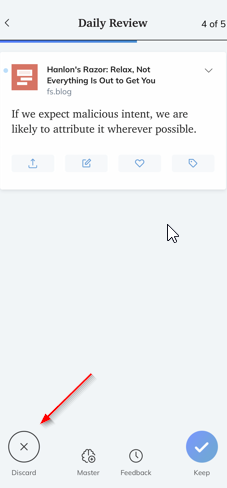
1/ Reviewing highlights in a smart way is one of the benefits of @readwise using their Daily Review feature. However, it is important to understand what the review buttons do, so as to efficiency of the process. For example, what does the "Discard" button do during a review? 

2/ Some might think it is designed to ignore it in the reviews. But in fact it does something different.
You use this when you decide a highlight doesn't have value to you.
Consider it a friendly delete. It removes the highlight from being reviewed and not to appear elsewhere.
You use this when you decide a highlight doesn't have value to you.
Consider it a friendly delete. It removes the highlight from being reviewed and not to appear elsewhere.
3/ Discards though are still available at: readwise.io/tags/discard
So they are not deleted, but rest in peace here without bothering you in other places in Readwise.
Now lets consider he other buttons in the review process.
So they are not deleted, but rest in peace here without bothering you in other places in Readwise.
Now lets consider he other buttons in the review process.
4/
Keep button - keep this highlight in your Readwise database and its likely to resurface in the future when Readwise determines its a good time.
Mastery - is for making Clozed flashcard (Question/answer style reviews)
Keep button - keep this highlight in your Readwise database and its likely to resurface in the future when Readwise determines its a good time.
Mastery - is for making Clozed flashcard (Question/answer style reviews)

5/ Feedback button, or perhaps in other Spaced Repetition systems would be called "Score"
This is where you tell Readwise if you want the highlight to come back sooner or later. You might compare this to scoring the highlight as easy to remember or hard to remember.
This is where you tell Readwise if you want the highlight to come back sooner or later. You might compare this to scoring the highlight as easy to remember or hard to remember.

6/ By learning how to use these buttons properly, you can finetune the way highlights are resurfaced for reviewing.
Lots of value to this system: your highlights don't disappear into a void, but are resurfaced for review in a smart way.
Lots of value to this system: your highlights don't disappear into a void, but are resurfaced for review in a smart way.
• • •
Missing some Tweet in this thread? You can try to
force a refresh









